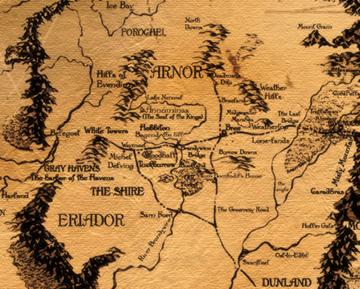Historically, the hobbits are known to have originated in the Valley of Anduin, between Mirkwood and the Misty Mountains. According to The Lord of the Rings, they have lost the genealogical details of how they are related to the Big People. At this time, there were three "breeds" of hobbits, with different physical characteristics and temperaments: Harfoots, Stoors and Fallohides. While situated in the valley of the Anduin River, the hobbits lived close by the Éothéod, the ancestors of the Rohirrim, and this led to some contact between the two. As a result many old words and names in "Hobbitish" are derivatives of words in Rohirric.
The Harfoots, the most numerous, were almost identical to the Hobbits as they are described in The Hobbit. They lived on the lowest slopes of the Misty Mountains and lived in holes, or Smials, dug into the hillsides.
The Stoors, the second most numerous, were shorter and stockier and had an affinity for water, boats and swimming. They lived on the marshy Gladden Fieldswhere the Gladden River met the Anduin (there is a similarity here to the hobbits of Buckland and the Marish in the Shire. It is possible that those hobbits were the descendants of Stoors). It was from these Hobbits that Déagol and Sméagol/Gollum were descended.
The Fallohides, the least numerous, were an adventurous people that preferred to live in the woods under the Misty Mountains and were said to be taller and fairer (all of these traits were much rarer in later days, and it has been implied that wealthy, eccentric families that tended to lead other hobbits politically, like the Tooksand Brandybucks, were of Fallohide descent). Bilbo and three of the four principal hobbit characters in The Lord of the Rings (Frodo, Pippin and Merry) had Fallohide blood through their common ancestor, the Old Took.
About the year T.A. 1050, they undertook the arduous task of crossing the Misty Mountains. Reasons for this trek are unknown, but they possibly had to do withSauron's growing power in nearby Greenwood, which later became known as Mirkwood as a result of the shadow that fell upon it during Sauron's search of the forest for the One Ring. The Hobbits took different routes in their journey westward, but as they began to settle together in Bree-land, Dunland, and the Angle formed by the rivers Mitheithel and Bruinen, the divisions between the Hobbit-kinds began to blur.
In the year 1601 of the Third Age (year 1 in the Shire Reckoning), two Fallohide brothers named Marcho and Blanco gained permission from the King of Arnor atFornost to cross the River Brandywine and settle on the other side. Many Hobbits followed them, and most of the territory they had settled in the Third Age was abandoned. Only Bree and a few surrounding villages lasted to the end of the Third Age. The new land that they founded on the west bank of the Brandywine was called the Shire.
Originally the hobbits of the Shire swore nominal allegiance to the last Kings of Arnor, being required only to acknowledge their lordship, speed their messengers, and keep the bridges and roads in repair. During the final fight against Angmar at the Battle of Fornost, the Hobbits maintain that they sent a company of archers to help but this is nowhere else recorded. After the battle, the kingdom of Arnor was destroyed, and in the absence of the king, the Hobbits elected a Thain of the Shire from among their own chieftains.
The first Thain of the Shire was Bucca of the Marish, who founded the Oldbuck family. However, the Oldbuck family later crossed the Brandywine River to create the separate land of Buckland and the family name changed to the familiar "Brandybuck". Their patriarch then became Master of Buckland. With the departure of the Oldbucks/Brandybucks, a new family was selected to have its chieftains be Thain: the Took family (Pippin Took was son of the Thain and would later become Thain himself). The Thain was in charge of Shire Moot and Muster and the Hobbitry-in-Arms, but as the Hobbits of the Shire led entirely peaceful, uneventful lives the office of Thain was seen as something more of a formality.
The Hobbits' numbers dwindled, and their stature became progressively smaller after the Fourth Age. However, they are sometimes spoken of in the present tense, and the prologue "Concerning Hobbits" in The Lord of the Rings states that they have survived into Tolkien's day.[14]

